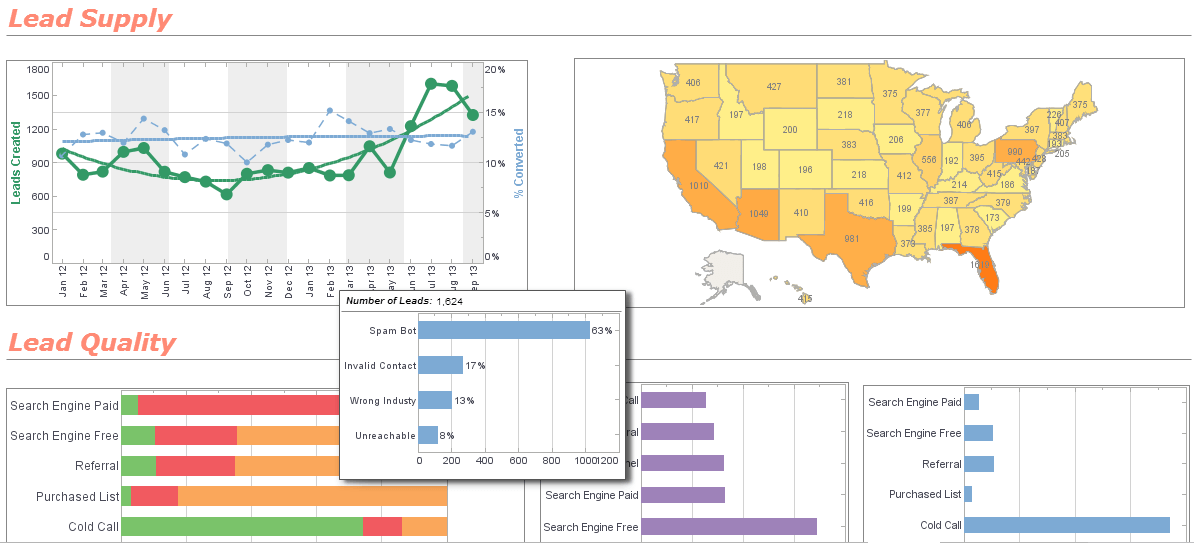Agile Data Access Environment
Below is the continuation of the transcript of a Webinar hosted by InetSoft on the topic of Agile Data Access and Agile Business Intelligence. The presenter is Mark Flaherty, CMO at InetSoft.
Mark Flaherty (MF): So start to think through in a very much of a silo-busting multiplatform virtualized environment, think of all of the business intelligence, ETL and MDM and other capabilities simply as services that you are going to rapidly enable through SOA, REST and other approaches to enable maximum reusability.
You never need to reinvent the wheel. If somebody has already built the best data cleansing capabilities, you simply need to invoke it. You don’t need to reinvent the wheel if somebody has already built the best data warehousing capabilities in terms of cubing services, you simply need to invoke it using a standard wrapper within your agile data access environment.
 |
View a 2-minute demonstration of InetSoft's easy, agile, and robust BI software. |
Vision of Integrated Data Platform
To move towards this vision, you need to begin to rethink your entire information analytics infrastructure, really rolling out to more comprehensive cross-application data governance and stewardship initiatives. You need to think in terms of end-to-end lifecycle metadata governance, predictive model governance in a way that you have never of before where predictive models have been traditionally rolled out in silos that are often associated with particular vendors’ tools and particular analytic data marts.
You need to start thinking through how to leverage predictive models and statistical analysis libraries as a resource that can brought to bear on all manner of analytics and BI projects. And often this comes down to, you need to prioritize going forward the disparate efforts to re-architect and reposition and reintegrate all of these disparate investments around this vision for agile data access. So clearly you need to work through these issues.
This is not something you can do overnight, it’s an ongoing program that you need to implement from the top town, from the CTO and CIO levels on down. And why would the C-level executives need to get involved because fundamentally this is all an enabler for key business initiatives that help you, for example, to flex your customer facing business processes such as customer service, sales, marketing, brand monitoring and so forth, to enable maximum flexibility to address new requirements that are coming, and from customers everywhere to address the need to move more of your customer outreach efforts into social media.
 |
Read the top 10 reasons for selecting InetSoft as your BI partner. |
Think of a Customer Touch Point Dashboard
So you need to really think through agility on the business process level and each of these touch points touches the customer very much needs advanced analytics delivered to them on the spot to help them make the best decision to retain the customer, to make a targeted offer to upsell them on new products to make the customer happy on an ongoing basis. So agility is very important. Analytics is key to that.
A customer touchpoint dashboard serves as a centralized tool for monitoring and analyzing interactions between customers and various touchpoints throughout their journey with a company. This dashboard provides valuable insights into customer engagement, satisfaction, and behavior across different channels and stages of the customer lifecycle. At its core, the dashboard aggregates data from multiple sources, such as website analytics, social media engagement, customer support tickets, and sales interactions, to provide a comprehensive view of the customer experience.
The dashboard typically includes key performance indicators (KPIs) and metrics related to customer interactions at each touchpoint. For example, it may display metrics such as website traffic, conversion rates, and average response times for customer inquiries. By visualizing these metrics in real-time or through historical trends, the dashboard enables stakeholders to quickly assess the effectiveness of various touchpoints and identify areas for improvement. Additionally, sentiment analysis tools can be integrated to monitor customer feedback and sentiment across different channels, providing valuable insights into customer perceptions and satisfaction levels.
Moreover, a customer touchpoint dashboard may include advanced analytics and predictive modeling capabilities to uncover deeper insights and trends. For instance, it may leverage machine learning algorithms to predict customer churn based on patterns of behavior or identify cross-selling opportunities based on past purchase history. By harnessing the power of data analytics, the dashboard empowers organizations to proactively address customer needs, personalize interactions, and optimize touchpoints to drive customer satisfaction, loyalty, and ultimately, business growth. Overall, a customer touchpoint dashboard serves as a strategic tool for aligning business strategies with customer expectations and delivering exceptional experiences across all touchpoints.
| Previous: Example of an Advanced Visualization |
Next: Mobile
BI
|
